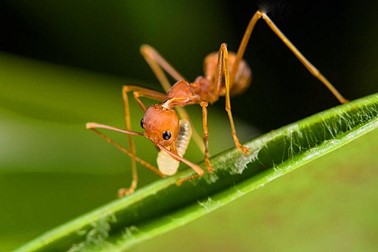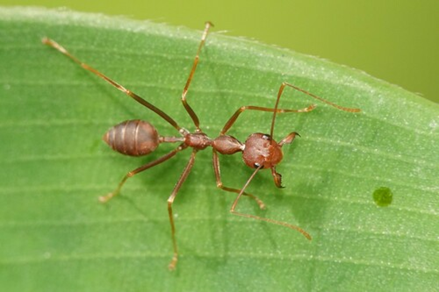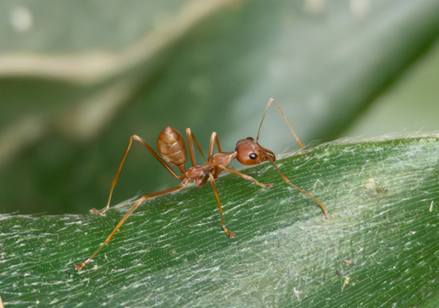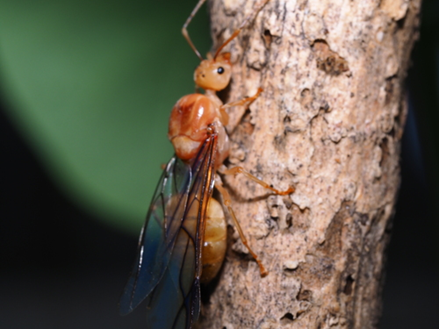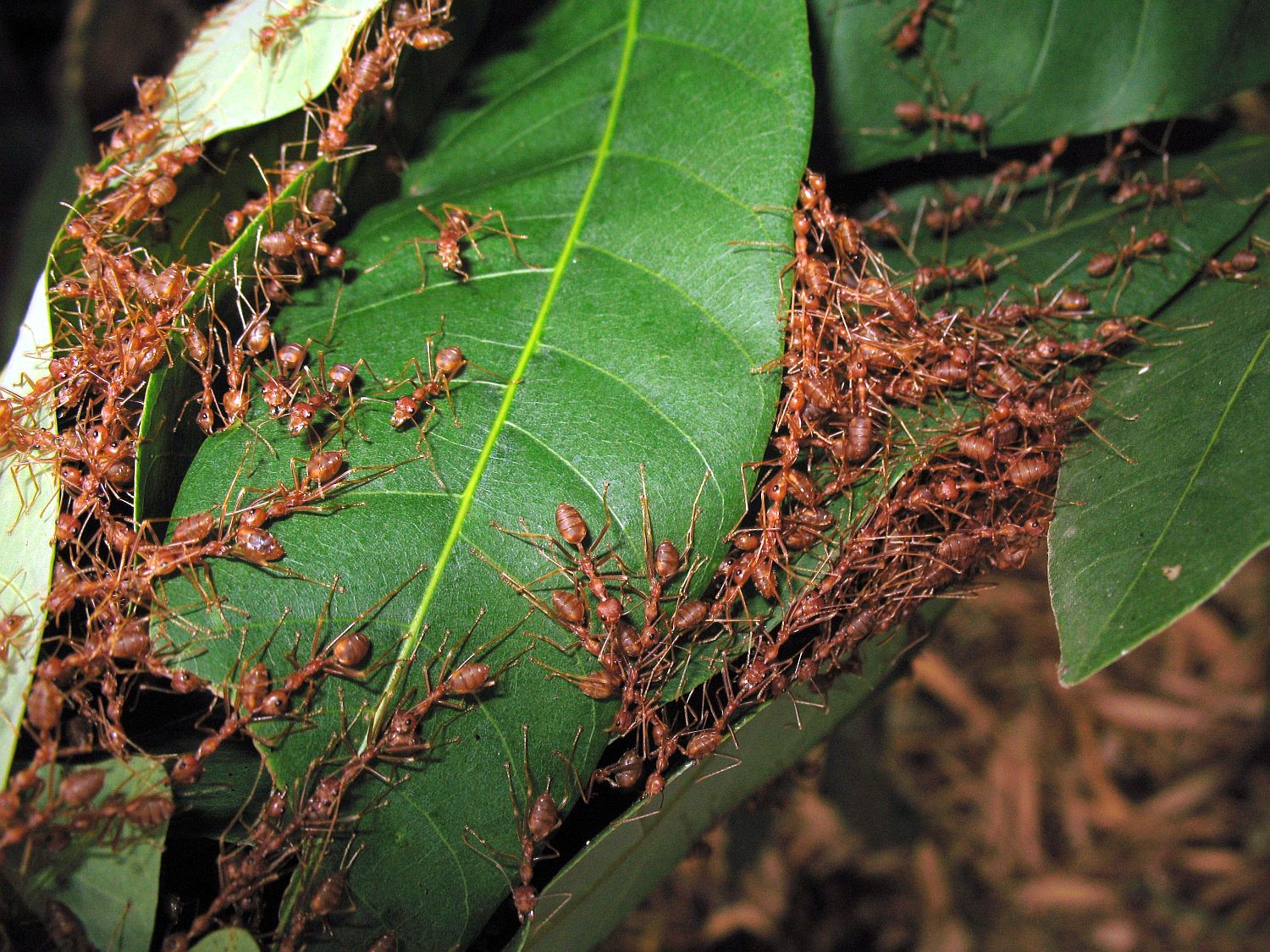ເລກລຳດັບທີ: 1194
ລະດັບການຮວບຮວມຂໍ້ມູນ: ເກີອບສົມບູນ
ປັບປູງຄັ້ງລ່າສຸດ: 2025-01-30
ມົດສົ້ມ
Weaver Ants
Oecophylla smaragdina (Fabricius, 1775)
ສັດ
ສັດທີ່ມີຂໍ້ຕໍ່
ແມງໄມ້
×
ຊື່ທ້ອງຖີ່ນ:
ມົດແດງ ( Asian weaver ant)
ຊື່ພ້ອງ
:
Formica smaragdina Fabricius, 1775
ຊື່ສະກຸນ:
Formicidae
ຊະນິດໃກ້ຄຽງ:
ບັນຍາຍລັກສະນະທາງພືດສາດ:
ມົດແດງ ຫຼື ມົດສົ້ມ (ມີຊື່ວິທະຍາສາດວ່າ: Oecophylla smaragdina) ໂດຍເປັນທີ່ຮູ້ຈັກກັນຈາກລັກສະນະພາຍນອກ ແລະ ໂຄງສ້າງທາງສັງຄົມພວກມັນບໍ່ຄືກຸ່ມອື່ນ.
ມົດຕົວແມ່ (ທີ່ບໍ່ມີປີກ) ຈະມີສີທີ່ແຕກຕ່າງກັນໄປຕັ້ງແຕ່ ສີຂຽວໄປຈົນຮອດສີນ້ຳຕານ. ໃນທາງກົງກັນຂ້າມກັນ ຕົວຜູ້ (ທີ່ມີປີກ) ມັກຈະມີສິດຳ ແລະ ມີຂະໜາດນ້ອຍກ່ວາລາຊີນີ. ລາຊີນີຈະມີສີຂຽວ ແລະ ມີປີກ.
ພາຍໃນອານາຈັກຂອງມົດແດງ ຈະມີມົດງານຢູ່ 2 ປະເພດ ໄດ້ແກ່:ມົດງານຫຼັກ ແລະ ມົດງານສຳຮອງ. ມົດງານຫຼັກຈະມີຂະໜາດໃຫຍ່ກ່ວາ ແລະ ເຮັດໜ້າທີ່ເປັນແຮງງານຫຼັກ ແລະ ເປັນກຸ່ມແຮງງານກໍ່ສ້າງອານາຈັກ ໂດຍທົ່ວໄປອານາຈັກໜຶ່ງຈະມີມົດງານຫຼັກຫຼາຍກ່ວາມົດງານຮອງ.
ໄລຍະການສືບພັນຂອງມົດແດງປະກອບດ້ວຍໄຂ່ຕົວອ່ອນ ແລະ ດັກແດ້, ໄຂ່ ແລະ ຕົວອ່ອນຈະມີສີຂາວ ແລະ ມີຮູບຮ່າງຄ້າຍກັນ ເຖິ່ງແມ່ນວ່າຕົວອ່ອນຈະມີຂະໜາດໃຫຍ່ກ່ວາກໍ່ຕາມ. ດັກແດ້ຈະມີລັກສະນະຄ້າຍກັບມົດໂຕເຕັມໄວ ໂດຍມີຕາ, ປາກ, ຂາ ແລະ ປີກ ທີ່ພັດທະນາແລ້ວ.
ແຫຼ່ງທີ່ມາ: [1].
ມົດຕົວແມ່ (ທີ່ບໍ່ມີປີກ) ຈະມີສີທີ່ແຕກຕ່າງກັນໄປຕັ້ງແຕ່ ສີຂຽວໄປຈົນຮອດສີນ້ຳຕານ. ໃນທາງກົງກັນຂ້າມກັນ ຕົວຜູ້ (ທີ່ມີປີກ) ມັກຈະມີສິດຳ ແລະ ມີຂະໜາດນ້ອຍກ່ວາລາຊີນີ. ລາຊີນີຈະມີສີຂຽວ ແລະ ມີປີກ.
ພາຍໃນອານາຈັກຂອງມົດແດງ ຈະມີມົດງານຢູ່ 2 ປະເພດ ໄດ້ແກ່:ມົດງານຫຼັກ ແລະ ມົດງານສຳຮອງ. ມົດງານຫຼັກຈະມີຂະໜາດໃຫຍ່ກ່ວາ ແລະ ເຮັດໜ້າທີ່ເປັນແຮງງານຫຼັກ ແລະ ເປັນກຸ່ມແຮງງານກໍ່ສ້າງອານາຈັກ ໂດຍທົ່ວໄປອານາຈັກໜຶ່ງຈະມີມົດງານຫຼັກຫຼາຍກ່ວາມົດງານຮອງ.
ໄລຍະການສືບພັນຂອງມົດແດງປະກອບດ້ວຍໄຂ່ຕົວອ່ອນ ແລະ ດັກແດ້, ໄຂ່ ແລະ ຕົວອ່ອນຈະມີສີຂາວ ແລະ ມີຮູບຮ່າງຄ້າຍກັນ ເຖິ່ງແມ່ນວ່າຕົວອ່ອນຈະມີຂະໜາດໃຫຍ່ກ່ວາກໍ່ຕາມ. ດັກແດ້ຈະມີລັກສະນະຄ້າຍກັບມົດໂຕເຕັມໄວ ໂດຍມີຕາ, ປາກ, ຂາ ແລະ ປີກ ທີ່ພັດທະນາແລ້ວ.
ແຫຼ່ງທີ່ມາ: [1].
ນິເວດວິທະຍາ
ເຂດກະຈາຍພັນທົ່ວໂລກ:
Native to Asia and Australia. [7]
ຊະນິດພັນພື້ນເມືອງຂອງປະເທດໃນເຂດອາຊີ ແລະ ອອສເຕເຣຍ. [7]
Global distribution between 2004 to 2024. Source: [2]
ເຂດກະຈາຍພັນທົ່ວໂລກຂອງມົດແດງ ລະຫວ່າງປີ 2004 ຫາ 2024. ແຫຼ່ງທີ່ມາ: [2]
ຊະນິດພັນພື້ນເມືອງຂອງປະເທດໃນເຂດອາຊີ ແລະ ອອສເຕເຣຍ. [7]
Global distribution between 2004 to 2024. Source: [2]
ເຂດກະຈາຍພັນທົ່ວໂລກຂອງມົດແດງ ລະຫວ່າງປີ 2004 ຫາ 2024. ແຫຼ່ງທີ່ມາ: [2]
ເຂດກະຈາຍພັນໃນລາວ
:
ເຂດພູສູງພາກເໜືອຂອງລາວ
ລຽບແມ່ນ້ຳຂອງພາກເໜືອ
ເຂດພູສູງສາຍພູຫຼວງ ແລະ ເຂດພູພຽງແຂວງຊຽງຂວາງ
ທົ່ງພຽງວຽງຈັນ
ເຂດສາຍພູຫຼວງພາກເໜືອ
ເຂດສາຍພູຫຼວງຕອນລຸ່ມ
ສາຍພູຫຼວງພາກໃຕ້
ເຂດລຽບແມ່ນ້ຳຂອງພາກໃຕ້
ພູພຽງບໍລິເວນ
ເຂດສາຍພູຫຼວງພາກກາງ
ລຽບແມ່ນ້ຳຂອງພາກເໜືອ
ເຂດພູສູງສາຍພູຫຼວງ ແລະ ເຂດພູພຽງແຂວງຊຽງຂວາງ
ທົ່ງພຽງວຽງຈັນ
ເຂດສາຍພູຫຼວງພາກເໜືອ
ເຂດສາຍພູຫຼວງຕອນລຸ່ມ
ສາຍພູຫຼວງພາກໃຕ້
ເຂດລຽບແມ່ນ້ຳຂອງພາກໃຕ້
ພູພຽງບໍລິເວນ
ເຂດສາຍພູຫຼວງພາກກາງ

ເຂດກະຈາຍພັນຕາມພູມສັນຖານ
:
ປ່າໄມ້ປ່ອງ
ປ່າແປກປະສົມປ່າໃບກ້ວາງ
ປ່າເຫຼົ່າອ່ອນ
ປ່າເຫຼົ່າແກ່
ປ່າແປກປະສົມປ່າໃບກ້ວາງ
ປ່າເຫຼົ່າອ່ອນ
ປ່າເຫຼົ່າແກ່
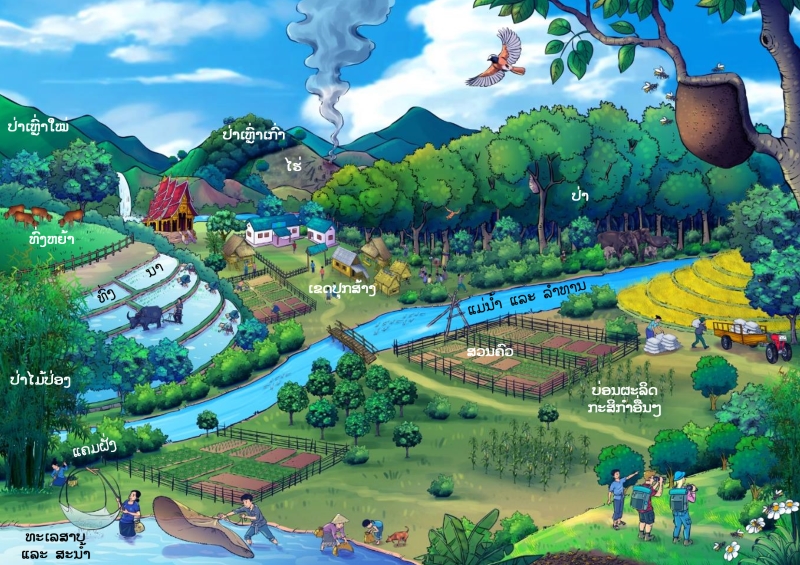
ສະເພາະຖິ່ນໃນລາວ:
ພື້ນເມືອງ
ຮຸກຮານ
:
ບໍ່ຮຸກຮານ
ສະຖານະພາບການອະນູຮັກ IUCN
:
ບໍ່ມີຄວາມສ່ຽງ
ສະຖານະພາບການອະນຸຮັກແຫ່ງຊາດລາວ
:
ບໍ່ຖືກລະບຸໃນບັນຊີປະເພດໃດ
ການນຳໃຊ້
ປະເພດການນຳໃຊ້:
ອາຫານ
ພືດເປັນຢາ
ກິດຈະກຳການກະເສດ
ພືດເປັນຢາ
ກິດຈະກຳການກະເສດ
ບັນຍາຍການນຳໃຊ້:
ອາຫານ: ໃນລາວ,ໄທ ແລະ ປະເທດອື່ນໆ, ຕົວອ່ອນ ແລະ ຕົວດັກແດ້ຂອງມົດແດງ ຖືກນຳມາບໍລິໂພກເປັນອາຫານທີ່ນິຍົມ ໂດຍເຊື່ອກັນວ່າມີລົດຊາດທີ່ແຕກຕ່າງກັນ ເຊັ່ນ: ມີລົດຊາດມັນ, ສົ້ມ ແລະ ມີລົດຄ້າຍໝາກໜາວ. ຕົວອ່ອນ ແລະ ດັກແດ້ຈະຖືກເກັບຮວບຮວມ ແລ້ວແປຮູບເປັນອາຫານ ແລະ ເຫຍື່ອປາ. [5]
ສະມຸນໄພ: ມົດໂຕເຕັມໄວຈະຖືກໃຊ້ເປັນຢາແຜນບູຮານເພື່ອຮັກສາພະຍາດຂໍ້ອັກເສບ, ນ້ຳມັນທີ່ເຮັດຈາກມົດໂຕເຕັມໄວໃຊ້ຮັກສາອານກຕິດເຊື້ອໃນກະເພາະອາຫານ ແລະເປັນຢາກະຕຸ້ນຄວາມຢາກອາຫານ. [5]
ກິດຈະກຳໃນຟາມ: ໃນອາຊີຕາເວັນອອກສ່ຽງໃຕ້ມົດແດງມັກຖືກໃຊ້ເພື່ອຫຼຸດຕົ້ນທຶນດ້ານສິ່ງແວດລ້ອມ ແລະ ຄ່າໃຊ້ຈ່າຍທາງການເງິນ ທີ່ກ່ຽວຂ້ອງກັບວິທີການຄວບຄຸມສັດຕູພືດ ແບບຊີວະພາບ. ມົດຊະນິດນີ້ສາມາດປົກປ້ອງແຫຼ່ງທີ່ຢູ່ອາໄສຈາກການໂຈມຕີຂອງແມ້ງໄມ້ສັດຕູພືດ ດັງນັ້ນຈຶ່ງຖືກນຳມາຄວບຄຸມທາງຊີວະພາບໃນເຂດຮ້ອນ [4]. ນອກຈາກນີ້ມົດຍັງຊ່ວຍເພີ່ມຜົນຜະລິດທາງກະສິກຳ ແລະ ກະຕຸ້ນໃຫ້ເກີດຄວາມຫຼາກຫຼາຍຂອງຜົນຜະລິດທາງການກະເສດທີ່ຢື່ນຍົງ. [5]
ສະມຸນໄພ: ມົດໂຕເຕັມໄວຈະຖືກໃຊ້ເປັນຢາແຜນບູຮານເພື່ອຮັກສາພະຍາດຂໍ້ອັກເສບ, ນ້ຳມັນທີ່ເຮັດຈາກມົດໂຕເຕັມໄວໃຊ້ຮັກສາອານກຕິດເຊື້ອໃນກະເພາະອາຫານ ແລະເປັນຢາກະຕຸ້ນຄວາມຢາກອາຫານ. [5]
ກິດຈະກຳໃນຟາມ: ໃນອາຊີຕາເວັນອອກສ່ຽງໃຕ້ມົດແດງມັກຖືກໃຊ້ເພື່ອຫຼຸດຕົ້ນທຶນດ້ານສິ່ງແວດລ້ອມ ແລະ ຄ່າໃຊ້ຈ່າຍທາງການເງິນ ທີ່ກ່ຽວຂ້ອງກັບວິທີການຄວບຄຸມສັດຕູພືດ ແບບຊີວະພາບ. ມົດຊະນິດນີ້ສາມາດປົກປ້ອງແຫຼ່ງທີ່ຢູ່ອາໄສຈາກການໂຈມຕີຂອງແມ້ງໄມ້ສັດຕູພືດ ດັງນັ້ນຈຶ່ງຖືກນຳມາຄວບຄຸມທາງຊີວະພາບໃນເຂດຮ້ອນ [4]. ນອກຈາກນີ້ມົດຍັງຊ່ວຍເພີ່ມຜົນຜະລິດທາງກະສິກຳ ແລະ ກະຕຸ້ນໃຫ້ເກີດຄວາມຫຼາກຫຼາຍຂອງຜົນຜະລິດທາງການກະເສດທີ່ຢື່ນຍົງ. [5]
ການປູກ ການລ້ຽງ:
ປູກ ແລະ ທຳມະຊາດ
ລະດູການເກັບກູ້:
ມັງກອນ
ກຸມພາ
ມີນາ
ເມສາ
ພຶກສະພາ
ກຸມພາ
ມີນາ
ເມສາ
ພຶກສະພາ
ການຕະຫຼາດ ແລະ ຕ່ອງໂສ້ມູນຄ່າ:
N/A
ການຄຸ້ມຄອງຈັດການ
N/A
ໂພຊະນາການ
ຄຸນຄ່າທາງໂພຊະນາການ:
ບັນຍາຍຄຸນຄ່າທາງໂພຊະນາການ:
N/A
| ສານອາຫານ | /100g | ໝາຍເຫດ |
|---|---|---|
| ໂປຣຕີນ | N/A | N/A |
| ຄາໂບໄຮເດຣດ | N/A | N/A |
| ໄຂມັນ | N/A | N/A |
| ວິຕາມິນ | N/A | N/A |
| ແຮ່ທາດ | N/A | N/A |
| ເສັ້ນໄຍ | N/A | N/A |
ອ້າງອິງ
ເຄດິດຮູບພາບ:
Asian Weaver Ant from above. [1] iNaturalist [Online]. Uploaded on 7 February 2024 by: sohkamyung. Available: www.inaturalist.org/photos/350616225. [Accessed: 27 September 2024].
Asian Weaver Ant from the side. [2] iNaturalist [Online]. Uploaded on 1 February 2024 by: victor0001. Available: www.inaturalist.org/photos/352160404. [Accessed: 27 September 2024].
Winge Asian Weaver Ant. [3] iNaturalist [Online]. Uploaded on 5 January 2024 by: ruidasilvapinto. Available: www.inaturalist.org/photos/344563569. [Accessed: 27 September 2024].
Asian Weaver Ant from the side. [2] iNaturalist [Online]. Uploaded on 1 February 2024 by: victor0001. Available: www.inaturalist.org/photos/352160404. [Accessed: 27 September 2024].
Winge Asian Weaver Ant. [3] iNaturalist [Online]. Uploaded on 5 January 2024 by: ruidasilvapinto. Available: www.inaturalist.org/photos/344563569. [Accessed: 27 September 2024].
ອ້າງອິງ:
[1] M. P. Marcela et al., "Colony Structure of the Weaver Ant, Oecophylla smaragdina (Fabricius) (Hymenoptera: Formicidae)," Sociobiolo-gy, Malaysia, vol. 59, no. 2, pp. 95-106, 2012.
[2] Global Biodiversity Information Facility (GBIF), “Oecophylla smarag-dina (Fabricius, 1775),” [Online]. Available: https://www.gbif.org/species/1317388. [Accessed: 27 September 2024].
[3] IUCN Red List of Threatened Species, "Oecophylla smaragdina," [Online]. Available: https://www.iucnredlist.org/search?query=Oecophylla%20smaragdina%20&searchType=species. [Accessed: 27 September 2024].
[4] K. Tsuji et al., "Asian weaver ants, Oecophylla smaragdina, and their repelling of pollinators," Ecological Research, vol. 19, no. 6, pp. 669–673, 2004.
[5] J. Itterbeeck, "Prospects of semi-cultivating the edible weaver ant Oecophylla smaragdina," Lao PDR, 2014.
[6] "Colony dynamics of the green tree ant (Oecophylla smaragdina Fab.) in a seasonal tropical climate. PhD thesis, James Cook Universi-ty," James Cook University, 2014. [Online]. Available: https://researchonline.jcu.edu.au/24114/2/02whole.pdf. [Accessed: Jan. 17, 2025].
[7] "Weaver Ants Convert Pest Insects into Food - Prospects for the Rural Poor," Tropentag 2009, 2009. [Online]. Available: https://www.tropentag.de/2009/abstracts/full/309.pdf. [Accessed: Jan. 17, 2025].
[2] Global Biodiversity Information Facility (GBIF), “Oecophylla smarag-dina (Fabricius, 1775),” [Online]. Available: https://www.gbif.org/species/1317388. [Accessed: 27 September 2024].
[3] IUCN Red List of Threatened Species, "Oecophylla smaragdina," [Online]. Available: https://www.iucnredlist.org/search?query=Oecophylla%20smaragdina%20&searchType=species. [Accessed: 27 September 2024].
[4] K. Tsuji et al., "Asian weaver ants, Oecophylla smaragdina, and their repelling of pollinators," Ecological Research, vol. 19, no. 6, pp. 669–673, 2004.
[5] J. Itterbeeck, "Prospects of semi-cultivating the edible weaver ant Oecophylla smaragdina," Lao PDR, 2014.
[6] "Colony dynamics of the green tree ant (Oecophylla smaragdina Fab.) in a seasonal tropical climate. PhD thesis, James Cook Universi-ty," James Cook University, 2014. [Online]. Available: https://researchonline.jcu.edu.au/24114/2/02whole.pdf. [Accessed: Jan. 17, 2025].
[7] "Weaver Ants Convert Pest Insects into Food - Prospects for the Rural Poor," Tropentag 2009, 2009. [Online]. Available: https://www.tropentag.de/2009/abstracts/full/309.pdf. [Accessed: Jan. 17, 2025].
ຜູ້ສ້າງ Factsheet:
ຜູ້ກວດສອບ Factsheet:
Daniela Barcelo, Biologists
